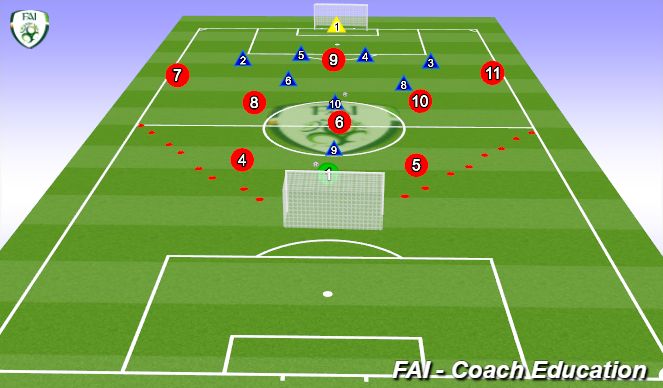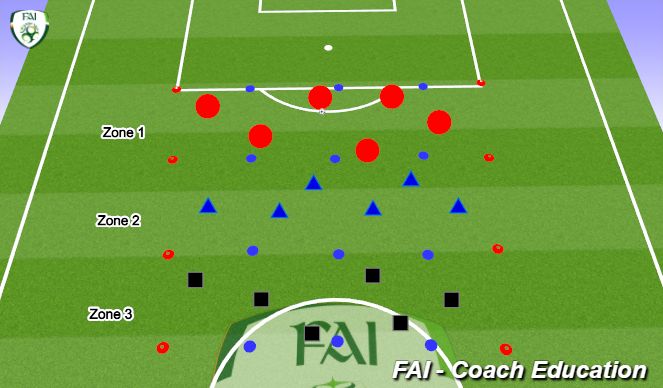Football/Soccer Session (Academy Sessions): Switching Play

Profile Summary

| Name: | Gaurav Sharma |
|---|---|
| City: | Amsterdam |
| Country: | Netherlands |
| Membership: | Adult Member |
| Sport: | Football/Soccer |
Description
Session objective: Switching Play.
Session duration: 75 minutes.
Session timelines:
5 minutes --> Warming up.
20 minutes --> Switch play in zones.
20 minutes --> 4 goals game.
2 minutes --> water break.
23 minutes --> 8+K v 8+K games.
5 minutes --> End of session talks and clean up.
This session is something I would like to plan on Monday because on Monday keepers have keepers training for first 45 minutes and then they can join the session for 8+k v 8+K.

See the guidance at the top of this page to understand why you are not seeing interactive Football/Soccer images.

4 goals game (20 mins)
Rules:
1) Both team has 2 mini goals where they can score in.
2) Red team can score in 2 goals which are place on the mid-line whereas Blue team can score on 2 goals which are placed on edge of 18 yard box.
3) Each goal scored is equal to 1 point.
4) The objective of this session is for players to recognize that if 1 goal is not free then they should combine and switch play to other side quickly in order to score an goal on the other side.
Coaching Points:
IN POSSESSION
1) The ball-carrier should, as much as possible, have lateral support on each side and behind at all times. This gives them simple options to play out of pressure.
2) The weight of the pass is important. When possible, big switches of play should be played into space and to feet. This will put the receiver closer to the goal and give the opposition less time to recover.
3) Scanning is critical to the players’ ability to read the situation and know where spaces are before receiving. This should allow them to find switches of play quickly, before the opposition can shift and recover their shape.
4) As with the previous practice, switches of play should occur directly with a big switch, or within two passes. This is to prevent the defence from having time to shift.
5) Upon recovering possession, the team shape should expand quickly and offer the the ball-carrier options to play out of any immediate pressure.
OUT OF POSSESSION:
1) Team shape and compactness is important to which ever team does not have possession. Being too stretched will allow for easy access to scoring zones.
2) With the scoring zones, the defending team should look to priorities defending the zone nearest to the ball at all times, and shift their block to the far zone upon switches of play.
3) Encourage aggressive counter-pressing upon any loss of possession, to increase the need for thein-possession team to play out of pressure.

See the guidance at the top of this page to understand why you are not seeing interactive Football/Soccer images.

Game situation (25 mins)
Rules:
1) 8+K v 8+K game format. Formation for the team to be coached 1-2-3-3. Formation for opponent: 1-4-3-1.
2) Normal game rules apply here.
3) The objective of this drill is for players to implement the things which they learned from previous 2 drills with regards to switching play at correct moment.
Coaching Points:
1) The ball-carrier should, as much as possible, have lateral support on each side and behind at all times. This gives them simple options to play out of pressure.
2) The weight of the pass is important. When possible, big switches of play should be played into space and to feet. This will put the receiver closer to the goal and give the opposition less time to recover.
3) Scanning is critical to the players’ ability to read the situation and know where spaces are before receiving. This should allow them to find switches of play quickly, before the opposition can shift and recover their shape.
4) As with the previous practice, switches of play should occur directly with a big switch, or within two passes. This is to prevent the defense from having time to shift.
5) Upon recovering possession, the team shape should expand quickly and offer the the ball-carrier options to play out of any immediate pressure.









 Play animation
Play animation Play step-by-step
Play step-by-step Repeat (toggle)
Repeat (toggle) Full Screen
Full Screen Pause
Pause Stop
Stop
Switching play between zones. (20 mins)
THREE-TEAM POSSESSION
RULES
• The playing area is divided into three zones, with each team of six players starting in separate zones – as shown.
• The objective for this practice is for the team in possession to play controlled from Zone 1 to Zone 3, or vice versa, bypassing Zone 2 in the process. As the teams are set up here, Team Circle plays with Team Square while Team Triangle are the defenders.
• Each successful pass bypassing the central zone is worth one point.
• If Team Circle starts with possession, one Team Triangle player can move from Zone 2 to Zone 1 to press. Team A should look to play over to Zone 3 at the first available
opportunity.
• For every four successful passes completed in Zone 1 or Zone 3, an extra player from Zone 2 will join in pressing the team in possession – a situation where two Team B
players are pressing is shown in Diagram 2.
• It is up to the team in possession to decide when the right time is to play over to the far zone. The more players they have attracted, the less time they will have
on the ball; however, there will then be fewer players in Zone 2 to block the passing lanes.
• If the defending team from Zone 2 wins possession or the ball goes out of play, a new ball will begin in the
opposite Zone (1 or 3). The defending team will begin pressing with one player in that zone, as before.
• If the ball is successfully played from one end zone to the other, the team from Zone 2 should transition their
press to the opposite zone and begin pressing again with one defender.
• Each round of play should last for one minute, before the teams rotate zones and a new team becomes the out-of-possession team.
COACHING DETAIL
IN POSSESSION
• This practice is designed to help the players understand the concepts of attracting pressure from the opposition,finding the free man through wall-passes or third-manmovements and playing out of pressure.
• The team in possession should focus on making theirzone as big as possible, by maintaining width and depthand distances between each player.
• Playing to the opposite zone at the first and bestavailable opportunity is important. The chance to switchplay is not always available, and it may be difficult tofind another good opportunity.• By maintaining possession longer (every four passes),the team in possession will attract more pressure (whenan extra defender enters their zone). This will give themless time and space, increasing the importance of quickpassing and few touches.
• Players should attempt to ‘play what they see’ as oftenas possible. If the ball-carrier is not facing in the rightdirection with good body shape to play a good pass,they should avoid trying to switch play.
• Wall-passes and third-man passes are key to creatingspace and good passing angles to switch the play.
• Playing to, and receiving on, the correct foot in relationto pressure will give the players in possession moretime and space to make their next decision and avoidthe pressure.
• Though technically not on the same team, the team inthe opposite far zone should be prepared to receive theswitch of play at all times.
• They should position themselves between the playersin Zone 2, as well as avoiding the cover shadows of theplayers who are pressing in the opposite zone.
OUT OF POSSESSION:
• Encourage the pressing players to press smartly andwith energy, giving the team in possession as little timeas possible on the ball.
• Defenders who are still in Zone 2 and not pressingshould remain active in their defensive positioning,shifting side to side as a unit and trying to block thepassing lanes to the opposite zone.
• When the ball goes out of play and a new ball is playedinto the opposite far zone, players from Zone 2 need totransition quickly into their shape in Zone 2. The firstplayer should also begin to press in the opposite zone.